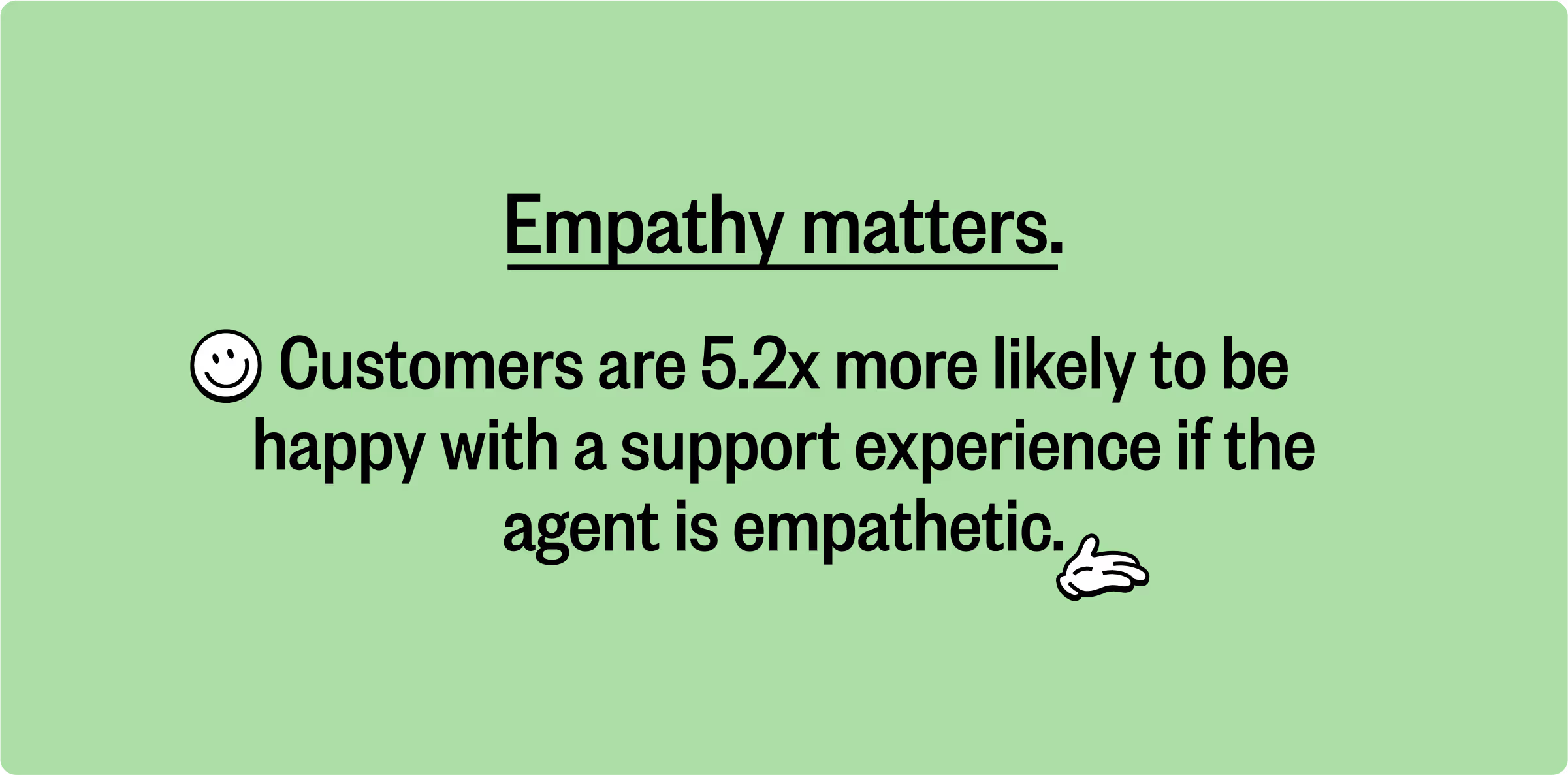5 customer support trends to watch in 2023

As customer demands and behaviors continue to change at a breakneck pace, delivering top-notch support feels like more of a moving target than ever before.
And yet, figuring out how to meet or exceed those expectations is crucial, with 88% of consumers saying the experience a company provides is equally as important as its products or services.
How can companies deliver on customers' increasingly lofty requirements? Well, staying on the cutting edge can help organizations anticipate needs and stay ahead of the curve (and the competition).
Don’t dust off your crystal ball quite yet. We did the hard work for you and dug into the research to pull together five customer support trends that will continue to shape the customer experience — and, as a result, the direction of your support team.
Trend #1: Organizations will prioritize proactive support
We already briefly mentioned anticipating needs, and that’s exactly what proactive customer support is: identifying a customer’s potential concerns or questions and reaching out with assistance — before they ever have a chance to contact you.

Customers increasingly expect companies to have these mind-reading capabilities, with 62% of consumers admitting that they think a company should be able to anticipate their needs effectively.
It might seem like an impossible task, but that’s where technology comes into play. Support leaders and teams will leverage advancements — particularly predictive analytics, which uses data, modeling, and machine learning to quite literally predict the future — to anticipate customers’ needs or challenges and get ahead of problems.
“Predictive analytics can provide early detection of precursors to change in customer behavior,” explained Adam Lichtl, Founder of Pacific Data Science, in an article for CIO. Put simply, it builds up a baseline of your customers’ behavior and gives you an advanced nudge if something is shifting.
This proactive approach obviously improves the customer experience and fosters an increased sense of trust. Fortunately, it’s also a boost for your support team. These proactive processes mean less last-minute scrambles to address issues and complaints, which translates to increased efficiency and less stress.
Your next steps
Even for support teams that aren’t quite ready to jump on the predictive analytics bandwagon, there are plenty of steps they can take to better understand the customer journey and lean on more proactive support channels, such as:
- Reach out to a random sampling of your customer base with a simple, “Is there anything we can help with?” message. It’s incredibly simple but equally powerful — and it might clue you in on some trends or common challenges that warrant better support moving forward.
- Similarly, end your service interactions by asking, “Is there anything else we can help with?” You can address numerous issues in one swoop, and one longer interaction is always cheaper and more efficient than multiple follow-up ones.
- Review data for your existing support channels and your overall customer experience to see if you spot any commonalities. For example, do people frequently reach out shortly after upgrading from a free to a paid account? That could be a signal that you should build a knowledge base or email sequence that would address common questions without them having to directly contact you.
- Include feedback forms on your website or send feedback forms after support interactions to get more customer insights.
- Use social listening to keep an ear to the ground on what customers are saying about your brand online.
- Connect with different teams throughout the organization — like product, marketing, and sales — to get their take on where customers could use more assistance.
Trend #2: Customers will expect more self-serve support options
In our culture of instant gratification (we want it and we want it now), your customers simply aren’t willing to wait for replies to their inquiries.

70% of customers say that they expect a customer service reply on the very same day. On more immediate channels like social media, the window is even shorter. 13% of consumers expect brands to respond on social media within an hour.
When customers are particularly eager to take action and move on, they might not be willing to wait for a support agent at all. That goes a long way in explaining why 81% of consumers expect more self-service options so they can find answers and information on their own.
The fact that customers want to take the DIY route and skip interacting with your friendly and well-trained agents might initially feel like a suckerpunch to your ego. But, it’s actually good news for workforce management leaders — many of whom continue to deal with staffing challenges.
Self-serve options give you an option to offload unnecessary or simple interactions so that your support team can save their time, focus, knowledge, and training for the highest-value, most challenging, or most emotionally sensitive customer exchanges.
Your next steps
This trend is another one that comes back to understanding the ins and outs of your customer journey — and particularly where people frequently get stuck.
When you pinpoint a common roadblock or bottleneck, identify what self-serve resources would best satisfy your customers’ needs. Keep in mind that self-serve options are best for high-frequency but low-complexity queries. A few self-serve options include (but certainly aren’t limited to):
- Knowledge base: An intuitively-organized knowledge base essentially gives your customers an entire resource library. Whether they can’t figure out how to change their password or are eager to make the most of a certain feature, they should be able to easily and painlessly find the information they need here — ideally with a search function.
- Video tutorials: Plenty of people are overwhelmed by lengthy instructions and dry manuals. If you’ve noticed that customers get stuck on a certain task or process, record a video tutorial (or a series of tutorials) to visually walk them through it.
- AI-powered chatbots: Keep in mind that not all chatbots are created equal. You need one that’s smart enough to actually help customers rather than send them spiraling into chatbot hell with never-ending, unhelpful prompts. And even the best of chatbots should be reserved for the quick, easy, and low-pressure customer interactions.
Trend #3: Artificial intelligence will take personalization to a new level
Artificial intelligence (AI) has been in the spotlight for a few years now, but the attention has really been kicked up a notch in recent months — and for good reason.
While AI might seem intimidating, it can make your support team far more efficient and organized in plenty of meaningful ways, including:
- Automating routine and repetitive tasks, like tagging and categorizing support interactions
- Offloading basic and straightforward interactions to chatbots
- Making all of your complicated customer data more digestible and actionable
But beyond boosting your operational efficiency, AI offers real advantages for customers as well — especially when it comes to highly personalized interactions.
Support teams can use machine learning and AI to gather and understand historical, behavioral, and social data and get a much more holistic understanding of customers. “AI-powered conversation intelligence can help brands with everything from service and support to sales and retention,” explained Swapnil Jain, CEO and Cofounder of Observe.AI, in an article for CMSWIRE.
And when 73% of customers expect companies to understand their unique needs and expectations, the ability to dig deep and synthesize all of that data and those touchpoints is crucial.
Your next steps
Put simply, you can’t afford to think of AI as a threat to the very existence of your support team — rather, it’s another tool in your toolbox that you can use to be more efficient and more effective.
There are seemingly limitless ways that your team can leverage AI. For example, it can run countless forecasting models and backtest them in a fraction of the time it would take you to do so manually. Or it can analyze email requests from your customers and route them to the best agents, rather than simply directing them to the next-available representative.
The key here is experimentation. Many CRM platforms already have integrated AI tools and features, so it’s worth looking into whatever solution your team is already using to see what other capabilities you could use to get a more complete picture of your customers.
Trend #4: Support agents will play an even more crucial role

All of the talk about technological advancements — AI, predictive analytics, machine learning, and more — is enough to make people think that we’re one small step away from robots entirely replacing live agents.
Take a deep breath. That couldn’t be further from the truth. There are still plenty of times when customers want to interact with a real, live human. And regardless of how far technology comes, that human-to-human service and interaction (and all of the empathy, trust, and rapport that come with it) can never be perfectly replicated.
Still not convinced? Qualtrics 2023 Global Consumer Trends Report states:
- A personable service agent has a bigger impact on consumer satisfaction than a short wait time.
- When a consumer talks to an empathetic agent, they are 5.2 times more likely to be happy with the overall experience than consumers who were not satisfied with how empathetic the agent was.
It goes to show that, when it’s done well, your customer support can be a cornerstone of your entire brand and organization. Your support team is uniquely positioned to foster trust and engender brand loyalty — arguably more than any other team or function within the company.
For example, think of all of the times that people have taken to social media to applaud Chewy’s personalized, sympathetic, and above-and-beyond support interactions. It’s not the clever marketing or the high-quality products that inspire people to so publicly sing Chewy’s praises — it’s their support.

Delivering this brag-worthy level of service is nearly impossible to do without living, breathing humans (so again, your support agents are safe from the robots). The challenge is for support leaders to find ways to balance the desire for human connection with the demand for efficiency and prompt responses — two things that often feel like they’re in direct competition with each other.
Your next steps
The key to striking that delicate balance is to get an understanding of when people crave or need human-to-human interactions and when people just want to get in, get an answer, and get out.
There are plenty of times when self-service or automated support is warranted. For example, 63% of people want to book airline tickets without ever talking to the airline. However, there are other times when human support is necessary.
There’s a lot of nuance here — different customers have different preferences. But your best bet is to comb through the data from your past support interactions to see if you can identify certain triggers, qualifiers, or circumstances when that human touch is non-negotiable.
And keep in mind that you can also give your customers a choice. Allowing them to select whether they want to pursue a self-serve option or be connected to a live agent puts them in the driver’s seat and gives them some ownership over their own journey. Plus, it’s a valuable data point as you learn more about which interactions typically require human intervention.
Trend #5: Support agents will become more intertwined in the entire organization
Good customer support is the backbone of any brand. It underscores quite literally everything else, so the lines between the customer support team and other departments are becoming increasingly blurry.
That’s especially true when looking at the marketing team, who is often fielding customer outreach on social media and other messaging channels. Survey data from Hootsuite shows that:
- 32% of companies say the marketing team exclusively is responsible for providing customer service via social and messaging apps.
- Only 7% of companies say the customer service team is exclusively responsible
In the majority of companies (58%), the marketing and customer service teams are working together to handle customer outreach through those channels.
Support and marketing aren’t the only teams with some overlap, though. In fact, it’s beneficial to build a solid feedback loop between customer support and a variety of other company functions. For example:
- The product team can get insights from customer support about highly-desired new features, products, and launches
- The sales team can learn a lot from customer support about what makes their existing customers tick, which they can use to improve sales strategies
That’s by no means an exhaustive list, but it does illustrate the power that your support team has. They’re the ones with their fingers on the pulse of the customer experience, and their own feedback and insights are valuable across the organization.
For that reason, brands need to be proactive about knocking down silos between customer support and all other departments so that they can collaborate more seamlessly and efficiently — and everybody can benefit from their in-the-trenches knowledge.
Your next steps
Particularly when you look at the overlap between marketing and support, it’s important to note that marketers can’t and shouldn’t replace customer support agents. But they’ll have to develop some familiarity in order to give customers the prompt responses they expect on social media and some other more immediate channels.
When the Hootsuite data shows that only 21% of marketers say they feel they do a good job servicing customers on social channels, they’ll need to be supported with training and resources to level-up their service.
Even small steps can help bring marketers up to speed on some support basics. Involve the marketing team (particularly social media team members) in customer support training sessions so they can benefit from that education. Or create resources — like knowledge base articles, support videos, or even canned and templated responses — to support them.
This doesn’t have to apply only to the marketing team. All of these approaches and assets can be a huge help to other teams that interact with customers or could benefit from a better understanding of how your support team fits in.
Most importantly, identify and establish a process to efficiently and seamlessly move customers over to a support team member for more complex or sensitive interactions. No other team member — not marketing, product, or anyone else — has the expertise and know-how to handle those interactions the way your support team does.
Customers are changing — support needs to change too
Today, customer expectations seem so fickle and ever-changing that they feel like they’re written in Jell-O.

In one recent report from Accenture, 88% of executives said they believe that customers and employees are changing faster than they can change their businesses — leading to what they call a “crisis of relevance.” In the same report, 67% of consumers say they expect companies to understand and address their changing needs.
It’s a tall order. And it’s a crucial one. In fact, improving customer experience is the fastest-growing priority area for customer care leaders who participated in a recent McKinsey survey.
How do you prioritize it? Start with support. The level of support you provide is a foundational element of your overall customer experience. Staying on top of trends (and adapting accordingly) can help you hit the customer support bullseye over and over again — even if the target keeps moving.




